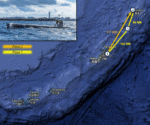China is accelerating its development of defensive technologies for military unmanned aerial vehicles (UAVs), focusing on countering electronic warfare threats such as GNSS spoofing and jamming. Recent advances also include secure communications links and shipboard landing systems that enhance the People’s Liberation Army’s (PLA) ability to deploy drones in contested environments. These upgrades reflect a broader effort by China to harden its UAV fleet against modern electronic attack while expanding their operational flexibility across domains.
GNSS Spoofing Detection Enhances Navigation Resilience
One of the most prominent threats facing modern military drones is Global Navigation Satellite System (GNSS) spoofing—a tactic that deceives UAVs by feeding them false positional data. In response, Chinese researchers at the National University of Defense Technology have developed a new detection method based on analyzing signal characteristics from multiple GNSS constellations. The system compares signal strength variations across GPS, GLONASS, Galileo, and BeiDou to identify anomalies indicative of spoofed signals.
This multi-constellation approach reportedly improves detection accuracy by over 90%, according to recent publications in Chinese defense journals. Unlike traditional single-source monitoring systems that are vulnerable to coordinated spoofing attacks, the PLA’s method leverages cross-referencing between satellite networks to flag inconsistencies in time synchronization or signal integrity.
The technology has been tested in simulated environments replicating battlefield conditions where GNSS jamming and spoofing are prevalent. While no operational deployment has been confirmed publicly, sources suggest integration is underway for medium-altitude long-endurance (MALE) platforms such as the Wing Loong II and CH-5 drones.
Covert Communication Links for Electronic Warfare Environments
In parallel with navigation defenses, China is enhancing the survivability of its UAV command-and-control (C2) links through covert communication protocols designed to operate under electronic attack. According to a May 2024 report by the PLA Daily and corroborated by open-source intelligence analysts at Janes Defence Weekly, Chinese engineers have developed low-probability-of-intercept (LPI) communication waveforms for drone telemetry and video feeds.
These waveforms use frequency hopping spread spectrum (FHSS) techniques combined with directional antennas and encryption layers tailored for contested electromagnetic environments. The goal is to prevent adversaries from detecting or jamming drone control signals during reconnaissance or strike missions near Taiwan or in the South China Sea.
- LPI/LPE comms reduce RF signature detectability
- Adaptive modulation enables bandwidth optimization under jamming
- Integration likely on GJ-11 Sharp Sword UCAVs and WZ-7 high-altitude ISR platforms
This capability aligns with broader PLA doctrine emphasizing information dominance (“信息优势”) in future conflicts. It also reflects lessons learned from observing Western drone operations in Syria and Ukraine where loss of link due to EW was a significant vulnerability.
Shipboard Landing Capabilities Expand Naval Drone Envelope
A key milestone in China’s naval drone integration came with successful shipboard landings of fixed-wing UAVs using arrestor cables aboard PLAN vessels. The system—demonstrated on a Type 075 amphibious assault ship prototype—uses an electro-optical tracking suite combined with inertial navigation inputs to guide drones onto deck-based recovery systems.
This capability allows MALE-class drones like the Wing Loong family or smaller tactical UAVs to operate from sea-based platforms without requiring vertical takeoff/landing (VTOL) configurations. It significantly extends their operational range beyond shore-based airfields while enabling persistent ISR coverage over maritime zones such as the Taiwan Strait or Spratly Islands.
The system mirrors U.S. Navy efforts with MQ-25 Stingray refueling drones but appears focused more on ISR/surveillance roles than aerial refueling. Chinese state media indicated trials began in late 2023 but did not specify which airframes were used beyond generic “fixed-wing UAV” references.
PLA’s Integrated Approach Reflects C4ISR Modernization Drive
The convergence of these technologies—anti-spoofing navigation tools, covert comms links, shipboard launch/recovery—reflects China’s push toward resilient C4ISR architecture under multi-domain conditions. By hardening its unmanned systems against EW threats while expanding their deployment options across land-sea-air boundaries, Beijing aims to close capability gaps with peer competitors like the United States.
This modernization aligns with China’s “Intelligentized Warfare” concept outlined in its most recent defense white papers. Under this doctrine:
- Drones must be able to operate autonomously when denied comms/GPS
- C4ISR nodes must be distributed across multiple domains for redundancy
- AI-enabled decision support tools will fuse sensor data from unmanned assets into actionable targeting information
The PLA Strategic Support Force (SSF), which oversees space-based ISR and EW units, is believed to be coordinating closely with drone developers like AVIC Unmanned Systems Division and CETC’s radar/electronic warfare labs to ensure interoperability across platforms.
Implications for Regional Security Dynamics
The evolution of China’s UAV defense suite carries significant implications for regional actors such as Taiwan, Japan, India—and U.S.-aligned forces operating in Indo-Pacific waters. Enhanced survivability makes Chinese drones harder targets during preemptive strikes or anti-access/area denial (A2/AD) scenarios.
Taiwanese analysts have warned that hardened PLA drones could conduct longer-duration surveillance missions over disputed airspace without fear of being jammed or misled via GNSS attacks. Similarly, shipborne recovery allows greater reach into first-island-chain theaters without reliance on mainland bases vulnerable to missile strikes.
The U.S., meanwhile, may need to adapt its own counter-UAS doctrine given these developments—emphasizing non-RF kill chains such as directed energy weapons or kinetic interceptors rather than jamming/spoofing alone.
Conclusion: Toward Resilient Autonomy at Scale
While much remains classified about China’s full suite of counter-EW defenses for drones, available evidence suggests a deliberate strategy toward resilient autonomy at scale—where unmanned systems can navigate contested airspace independently while maintaining secure data flows back to command centers or ships at sea.
This trajectory mirrors global trends but also underscores how Beijing is learning rapidly from foreign conflicts while tailoring solutions specific to its geographic priorities—from island chains to border plateaus. As these capabilities mature into fielded systems over the next two years, they will reshape both tactical planning and strategic deterrence calculations across Asia-Pacific theaters.









